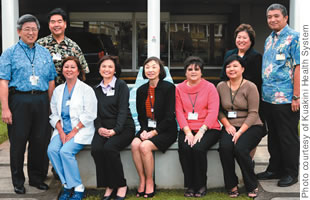A Cancer Collaboration

By Gary K. Kajiwara
President and CEO for Kuakini Health System
After graduating from Roosevelt High School, I initially wanted to become a physician, then a dentist. However, while waiting as an alternate for a Mainland dental program, I was accepted by the University of Hawaii (UH) School of Public Health. I also was fortunate to be the second student in the new joint master’s degree program with the College of Business Administration. As with life’s twists and turns, my career goal changed to health care administration.
I am forever grateful to Wil J. Henderson for selecting me for administrative intern/resident positions at The Queen’s Medical Center and helping me get my foot in the door. I was offered an administrative position at Kuakini Medical Center in 1976, and I have been fortunate to serve as Kuakini’s president and CEO since 1990.
Kuakini Health System and its subsidiaries have been providing health care services since 1900. We are very proud of Kuakini’s heritage, and are committed to continue our founders’ legacy as the last surviving hospital in the U.S. established by Japanese immigrants.
In the mid-1960s, Kuakini had clinicians and research-oriented staff who understood the value of research as a core business. With the ongoing support of the administration and Hawaii research cohorts (8,006 WWII Japanese-American veterans), Kuakini has successfully sponsored several longitudinal research programs: Honolulu Heart Program, Japan-Hawaii Cancer Study and Honolulu-Asia Aging Study. Collectively, these nationally and internationally renowned research programs have received more than $70 million of funding from the National Institutes of Health. These funds have been committed to conducting research in Hawaii and contracting with local and Mainland research centers, including Pacific Health Research Institute.

|
Kuakini is one of only two research sites in the U.S. with more than 40 years of clinical and epidemiological data, and blood and tissue specimens collected from a homogeneous group of participants. Locally, research funds have created jobs, developed a core of Island researchers, provided valuable research findings to the worldwide community, built Kuakini’s research reputation and ties with research centers in Asia, and provided Kuakini with access to high-tech equipment and donations in technology that would not have been possible if Kuakini was not recognized for its research initiatives.
Hawaii is an ideal location for research of all types, including cancer research. Newly diagnosed cancer cases are expected to increase by 23 percent in the next decade, with the Medicare-eligible population having the largest portion of the increase.
Recognizing that cancer is a chronic disease with a high incidence in the elderly population, Kuakini will continue its longitudinal research and pursue its plans to acquire a PET/CT scanner and construct a new research building to archive the growing volume of cohort specimens and to provide offices for researchers.
For sustained cancer research in Hawaii, collaboration among the major hospitals, the Cancer Research Center of Hawaii (CRCH) and John A. Burns School of Medicine (JABSOM) is critical, since no single organization has unlimited resources and universal research expertise to be the center of all cancer research. Also, the key players in Hawaii have different goals and focus on research.
The collaboration of The Queen’s Medical Center, Hawaii Pacific Health and Kuakini Health System with CRCH and JABSOM is a positive step toward maximizing the opportunities and worldwide value that Hawaii can bring to cancer research.
As part of this collaboration, a jointly sponsored translational cancer medicine symposium is being held Feb. 17 and 18 at The Queen’s Conference Center. Kuakini is proud to join this opportunity to promote the benefits of cancer research in Hawaii.
E-mail this story | Print this page | Comments (0) | Archive | RSS Comments (0) |
Most Recent Comment(s):




 Del.icio.us
Del.icio.us








